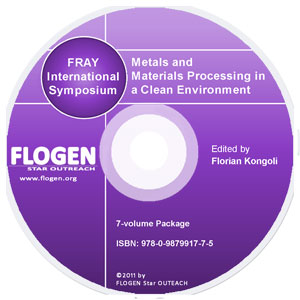
CD shopping page |
2011-Sustainable Industrial Processing Summit
|
| Editors: | Florian K |
| Publisher: | Flogen Star OUTREACH |
| Publication Year: | 2012 |
| Pages: | 764 pages |
| ISBN: | 978-0-9879917-5-1 |
| ISSN: | 2291-1227 (Metals and Materials Processing in a Clean Environment Series) |
Synthesis Of Nano-particles Bearing Materials By Hydrogen Reduction
Eduardo Brocchi1;1CATHOLIC UNIVERSITY OF RIO DE JANEIRO, Rio de Janeiro, Brazil;
Type of Paper: Regular
Id Paper: 361
Topic: 14
Abstract:
It is well recognized the importance of nano-structured materials in the present technological stage. Due to their unique properties these materials can be used in a large number of applications. It is also well stablished that materials properties can be severely altered by giving them a nano-structured condition. In that sense, some materials can even be designed in order to fulfill the need for high performance in some specifics functions. One example is the growing interest in nanocomposites, in which a very fine dispersion of a ceramic phase in a metal matrix will significantly improve the material properties. In view of that, extensive studies have been carried out on a variety of materials such as alloys and different types of composites.Recently, our group at the Department of Material Science and Metallurgy of Rio de Janeiro Catholic University has developed an alternative chemical based synthetizing route to obtain nano-structured materials. This approach can be applied to the production of oxides, metals, composites and alloys. In the last two cases with a high level of homogeneity.Recently, the authors have developed a novel chemical and powder metallurgy method for in-situ formations of Cu-Al2O3 and Ni-Al2O3 nanoscale composites by decomposition of their mixed nitrate solutions, to coform the nano oxides, followed by preferential reduction of CuO or NiO by hydrogen at very low temperature. Studies carried out by the authors on the kinetics of reduction of such fine oxides indicated that under low partial pressure of hydrogen (0.25 atm) in argon, the oxides of Ni and Cu can be reduced completely, in a low temperature range of 523 to 623 K. The composites containing nanosize metal-metal oxide particles, have been found to be quite homogeneous in nature. In view of this, Cu-Ni alloy was produced by mixing the aqueous nitrate solutions of copper and nickel, followed by decompositions of their nitrates to their mixed oxides and subsequent low temperature hydrogen reduction. The alloy powder has been characterized and cold pressed and sintered to determine the density, hardness and workability. In that context, the purpose of the present work is to address the fundamental aspects of the synthesis procedure, emphasing the thermodynamics background of the two steps involved. Also, the work aims to illustrate the outcome, by presenting experimental conditions and providing relevants characterization of the obtained nano-materials, by means of electron microscopy and microanalytical techniques. Examples are given in terms of individual and co-formed oxides and composites.